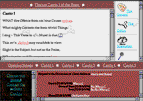| Joi Chevalier thinks about Early Modern Studies, the WWW, and MUSHSpace! |
|---|
| Roger Chartier's Order of Books and Stephen Booth's principles of close reading both influenced an idea that I had about students' relationships to texts. Chartier's text, object, author dynamic would prove useful in talking not only about print culture, but about computer and MUSH culture as well. The World Wide Web eventually serves as a place where these two cultures, print and computer, meet. |
| Daniel Anderson thinks about Richard Lanham's hypertext theory and social construction and MU*s. | |
|---|---|
| Theorists have responded to post-structuralism in a number of ways. Some reassert the possibilities of fixed associations and meaning, while others like Stanley Fish or perhaps Kenneth Bruffee try to displace meaning and structure to the realm of the social. Others have gone ahead and made do. One theorist of hypertext, Richard Lanham, suggests that we welcome the reciprical movements that swirl in the wake of deconstruction. That we tune into and make use of oscillation. | Since deconstruction a number of theorists have invested in social constructions. Social constructionist theory (in its purest form) assumes that metaphysics and constructions of the self are located in and created by the social matrix. Underlying these conceptions is the knowledge that reality and the self is constructed by language. There are obvious connections between MU*s and social constructionism. |
| Daniel Anderson's discussion of the teaching goal of incorporating discourse learning into a Rape of the Lock Web courseware project also treats literary theory. |
|---|
 Since discourse
about a literary text foregrounds issues of interpretation, I wanted this project
to enact certain aspects of reader-response criticism. The project uses cgi-bin
technology to allow anyone with a web connection to post messages about various
aspects of the poem. The goal is to enact an interpretive community in the
(hyper)text itself and in doing so bring additional perspectives into the
interpretation of the work and show students that the meaning of the text emerges
from both the original document and the voices that articulate it. You can get more analysis by going to the Rape of the Lock and discourse
communities page. Since discourse
about a literary text foregrounds issues of interpretation, I wanted this project
to enact certain aspects of reader-response criticism. The project uses cgi-bin
technology to allow anyone with a web connection to post messages about various
aspects of the poem. The goal is to enact an interpretive community in the
(hyper)text itself and in doing so bring additional perspectives into the
interpretation of the work and show students that the meaning of the text emerges
from both the original document and the voices that articulate it. You can get more analysis by going to the Rape of the Lock and discourse
communities page.
|